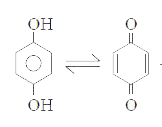The quinhydrone electrode (Q,H⊕∣H2Q) is used in conjunction with a saturated calomel electrode, as represented below:
EMFcell=0.264V at 30∘C. Calculate the pH of unknown solution at this temperature.
Given :Ecalomel=0.24V and Ec−.2H⊕,Q∣H2Q=0.7V
 Solution in Kannada
Solution in Kannada
( Note that the value 2.303RTFat30∘C=0.06)
ESCE=0.242V
Equinhydrone=Ec−.quinhydrone−0.06pH(at30∘C)
∴Ecell=ERHS−ELHS=Equinhydrone−ESCE
0.264V=0.7−0.06pH−0.24( at30∘C)
∴pH=0.7−0.24−0.2640.06=3.266≈3.27
Similar Questions
The calomel electrode can be represented as
View SolutionFor the half cell,

+2H+2e−.E0=
1.30 V. At pH=2, electrode potential of the given quinhydrone half cell is :
View SolutionThe e.m.f of the cell : H2(g) |Buffer | Normal calomel electrodes is 0.6885 volt at 25∘C, when barometric pressure is 760 mm Hg. What is the pH of the buffer solution ? Given E∘calomel=0.28 volt
View SolutionThe calomel electrode can be represented as _________.
View SolutionThe emf of the cell, (Pt) H_2|H^+ (c=unknown) ||KCN soln. |HgCl_2|Hg is 0.4783 V. IF the electrode potential of the calomel chloride is +0.2420 volt (reduction), calculate pH of the solution.
View SolutionFind the EMF of the cell at 25∘C.

Ec−.red(quinhydrone electrode )=0.699V
Ec−.red( calomel electrode)=+0.268V.
View SolutionThe EMF of the cell :
Pt∣∣Ce4+(90%),Ce3+(10%)∣∣ Normal calomel electrode is 1.464V at 25∘C. Find the value of equilibrium constant of the reaction :
2Ce3++2H⊕→2Ce4++H2
The electrode potential of the normal calomel electrode is +0.28V.
View SolutionFor the half cell, +2H^(+)2e^(-).E^(0)= 1.30 V. At pH = 2 , electrode potential of the given quinhydrone half cell is :
View Solution

